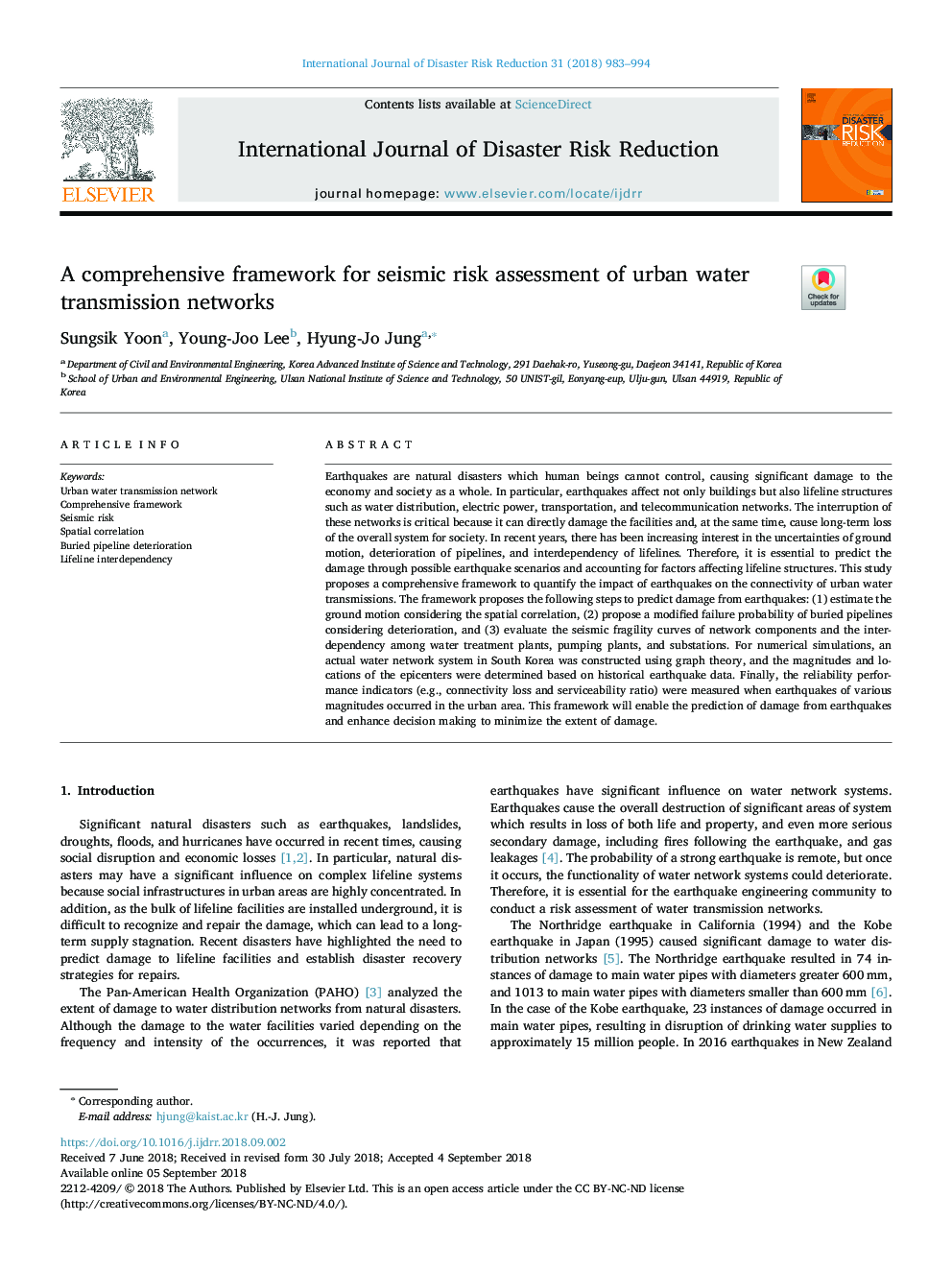| کد مقاله | کد نشریه | سال انتشار | مقاله انگلیسی | نسخه تمام متن |
|---|---|---|---|---|
| 11005301 | 1485138 | 2018 | 12 صفحه PDF | دانلود رایگان |
عنوان انگلیسی مقاله ISI
A comprehensive framework for seismic risk assessment of urban water transmission networks
ترجمه فارسی عنوان
یک چارچوب جامع برای ارزیابی خطر لرزه ای شبکه های انتقال آب شهری
دانلود مقاله + سفارش ترجمه
دانلود مقاله ISI انگلیسی
رایگان برای ایرانیان
کلمات کلیدی
شبکه انتقال آب شهری، چارچوب جامع، ریسک لرزه ای، همبستگی فضایی، خرابی خط لوله خالی وابستگی به زندگی
ترجمه چکیده
زمین لرزه ها بلایای طبیعی هستند که انسان ها نمی توانند کنترل کنند، و باعث ایجاد آسیب قابل توجهی به اقتصاد و جامعه می شود. به ویژه، زمین لرزه ها نه تنها ساختمان ها بلکه ساختارهای زندگی مانند توزیع آب، برق، حمل و نقل و شبکه های مخابراتی را نیز تحت تاثیر قرار می دهند. قطع این شبکه ها بسیار مهم است زیرا می تواند به طور مستقیم به امکانات آسیب برساند و در عین حال باعث از دست رفتن سیستم جامع جامعه می شود. در سال های اخیر توجه بیشتری به عدم قطعیت حرکت زمین، تضعیف خطوط لوله و وابستگی متقابل خطوط زندگی افزایش یافته است. بنابراین، ضروری است پیش بینی آسیب از طریق سناریوهای احتمالی زلزله و حسابداری برای عوامل موثر بر ساختارهای پایه. این مطالعه یک چارچوب جامع برای ارزیابی تاثیر زلزله بر روی ارتباطات انتقال آب شهری ارائه می دهد. چارچوب پیشنهادات مراحل زیر را برای پیش بینی آسیب از زمین لرزه پیشنهاد می کند: (1) تخمین حرکت زمین با توجه به همبستگی فضایی، (2) پیشنهاد شکست احتمالی شکست لوله های خالی را با توجه به خرابی، و (3) ارزیابی منحنی های شکنندگی لرزه ای از اجزای شبکه و وابستگی متقابل در میان گیاهان تصفیه آب، پمپاژ گیاهان، و زیرزمین. برای شبیه سازی های عددی، یک سیستم شبکه واقعی آب در کره جنوبی با استفاده از نظریه گراف ساخته شد، و مقادیر و مکان های اپیزودها بر اساس داده های زلزله تاریخی تعیین شد. در نهایت شاخص های قابلیت اطمینان (مثلا از دست دادن اتصال و قابلیت کارکرد) در هنگام اندازه گیری زمین لرزه های مختلف در منطقه شهری اندازه گیری شد. این چارچوب پیش بینی آسیب زمین لرزه ها را افزایش داده و تصمیم گیری را برای به حداقل رساندن میزان آسیب افزایش می دهد.
موضوعات مرتبط
مهندسی و علوم پایه
علوم زمین و سیارات
فیزیک زمین (ژئو فیزیک)
چکیده انگلیسی
Earthquakes are natural disasters which human beings cannot control, causing significant damage to the economy and society as a whole. In particular, earthquakes affect not only buildings but also lifeline structures such as water distribution, electric power, transportation, and telecommunication networks. The interruption of these networks is critical because it can directly damage the facilities and, at the same time, cause long-term loss of the overall system for society. In recent years, there has been increasing interest in the uncertainties of ground motion, deterioration of pipelines, and interdependency of lifelines. Therefore, it is essential to predict the damage through possible earthquake scenarios and accounting for factors affecting lifeline structures. This study proposes a comprehensive framework to quantify the impact of earthquakes on the connectivity of urban water transmissions. The framework proposes the following steps to predict damage from earthquakes: (1) estimate the ground motion considering the spatial correlation, (2) propose a modified failure probability of buried pipelines considering deterioration, and (3) evaluate the seismic fragility curves of network components and the interdependency among water treatment plants, pumping plants, and substations. For numerical simulations, an actual water network system in South Korea was constructed using graph theory, and the magnitudes and locations of the epicenters were determined based on historical earthquake data. Finally, the reliability performance indicators (e.g., connectivity loss and serviceability ratio) were measured when earthquakes of various magnitudes occurred in the urban area. This framework will enable the prediction of damage from earthquakes and enhance decision making to minimize the extent of damage.
ناشر
Database: Elsevier - ScienceDirect (ساینس دایرکت)
Journal: International Journal of Disaster Risk Reduction - Volume 31, October 2018, Pages 983-994
Journal: International Journal of Disaster Risk Reduction - Volume 31, October 2018, Pages 983-994
نویسندگان
Sungsik Yoon, Young-Joo Lee, Hyung-Jo Jung,
